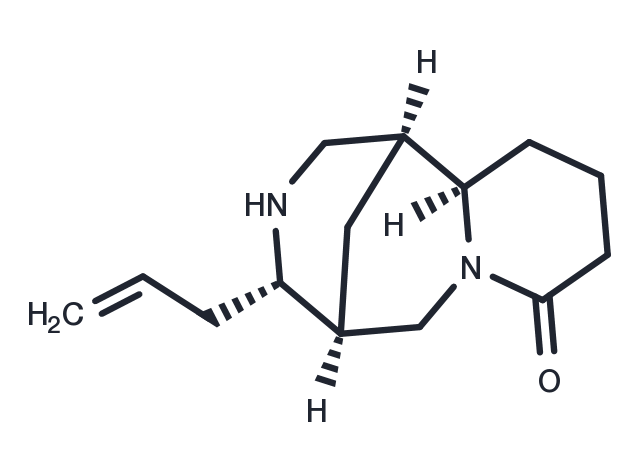Powder: -20°C for 3 years | In solvent: -80°C for 1 year


Angustifoline has activity against gram-positive bacteria. It inhibits human colon cancer cell growth by inducing autophagy along with mitochondrial-mediated apoptosis, suppression of cell invasion and migration and stimulating G2/M cell cycle arrest.

| Pack Size | Availability | Price/USD | Quantity |
|---|---|---|---|
| 5 mg | Inquiry | $ 460.00 | |
| 1 mL * 10 mM (in DMSO) | Inquiry | $ 470.00 |
| Description | Angustifoline has activity against gram-positive bacteria. It inhibits human colon cancer cell growth by inducing autophagy along with mitochondrial-mediated apoptosis, suppression of cell invasion and migration and stimulating G2/M cell cycle arrest. |
| In vitro | Twelve lupine alkaloids, eight from Lupinus polyphyllus (Lindl), were tested in feeding bioassays against sixth instar spruce budworm, Choristoneura fumiferana (Clemens). METHODS AND RESULTS: Feeding deterrence was found in the alkaloid fraction of L. polyphyllus extracts. Eight lupine alkaloids shown to be present in the extract were tested at the rate of 25 μg per feeding disc. Of these compounds, 13-trans-cinnamoyloxylupanine and 13- tigloyloxylupanine were highly deterrent, whereas lupanine, sparteine, 13-hydroxylupanine, tetrahydrorhombifoline, Angustifoline, and 17-oxolupanine, were not. Four alkaloids not present in L. polyphyllus, lupinine, epilupinine, α-isolupanine, and lupinyl-trans-cinnamate, were not active at 25 μg per feeding disc. CONCLUSIONS: Clearly, there is wide variability in the response of spruce budworm larvae, which are not adapted to feeding on alkaloids, to various alkaloids within the same structural class. If this variability in response is general among herbivores, perhaps the presence of an alkaloid is not significant with regard to defense, whereas diversity in structure of alkaloids may deter generalist grazers. |
| Source |
| Molecular Weight | 234.343 |
| Formula | C14H22N2O |
| CAS No. | 550-43-6 |
Powder: -20°C for 3 years | In solvent: -80°C for 1 year
You can also refer to dose conversion for different animals. More
bottom
Please see Inhibitor Handling Instructions for more frequently ask questions. Topics include: how to prepare stock solutions, how to store products, and cautions on cell-based assays & animal experiments, etc.
Angustifoline 550-43-6 inhibitor inhibit
